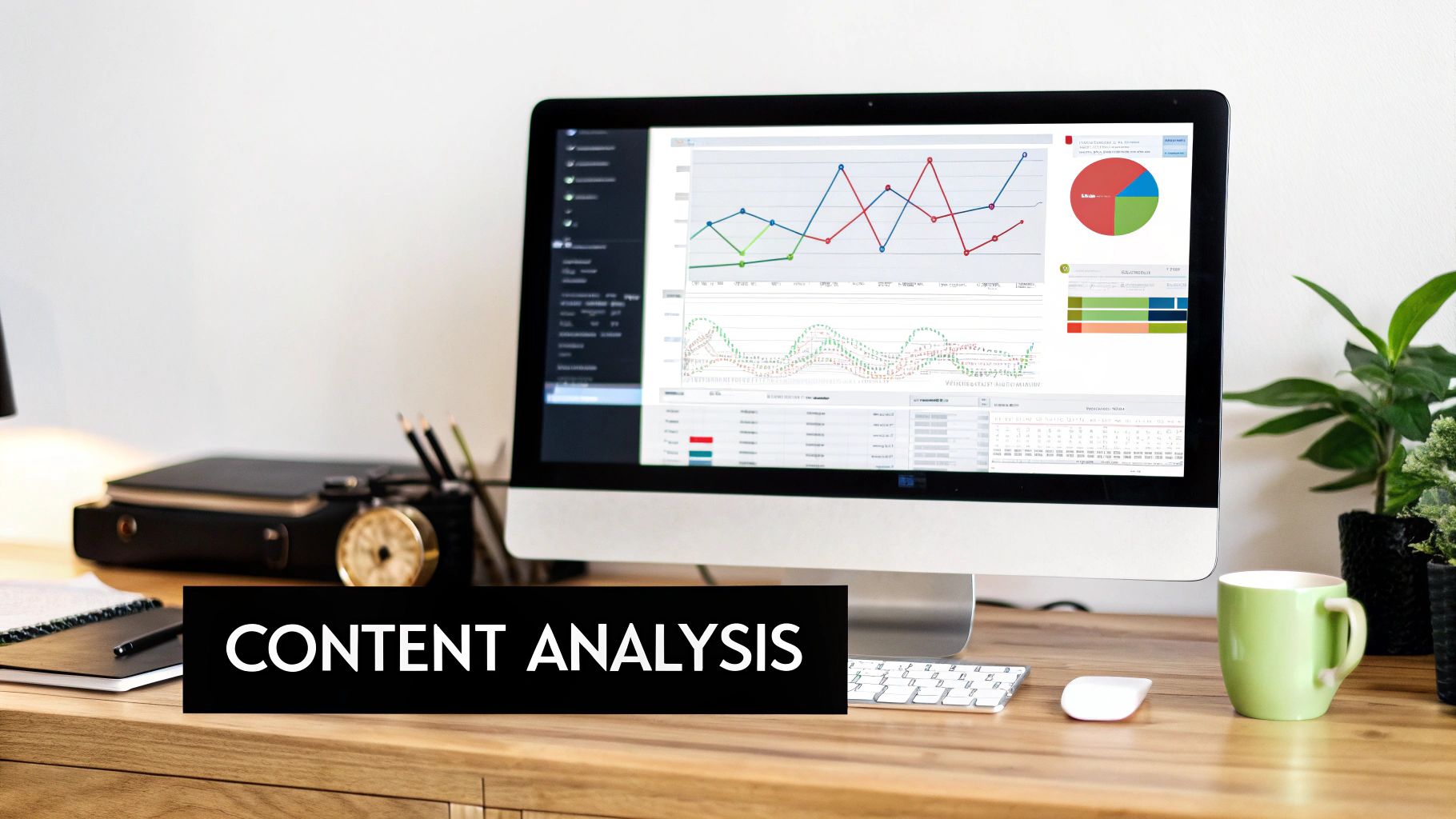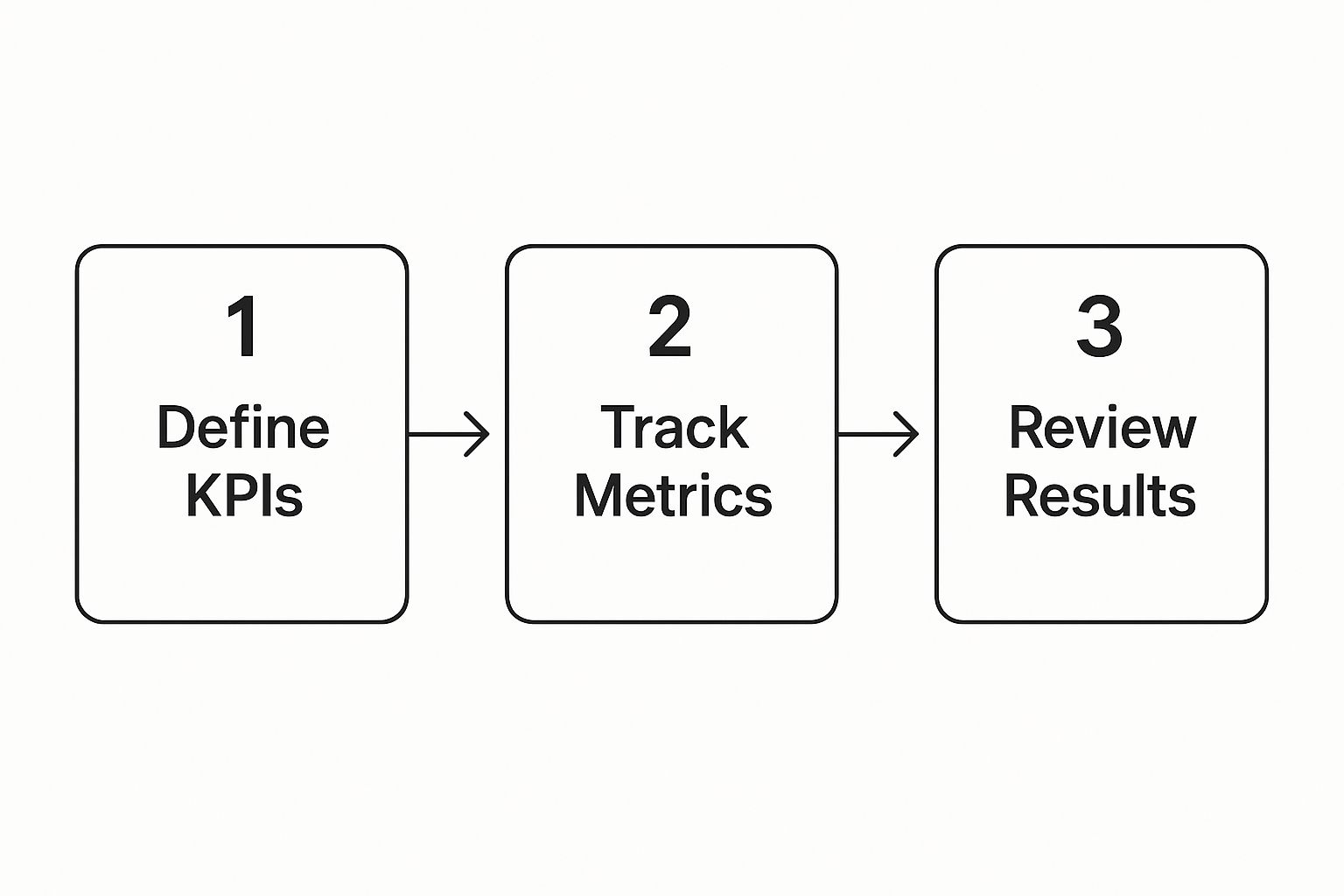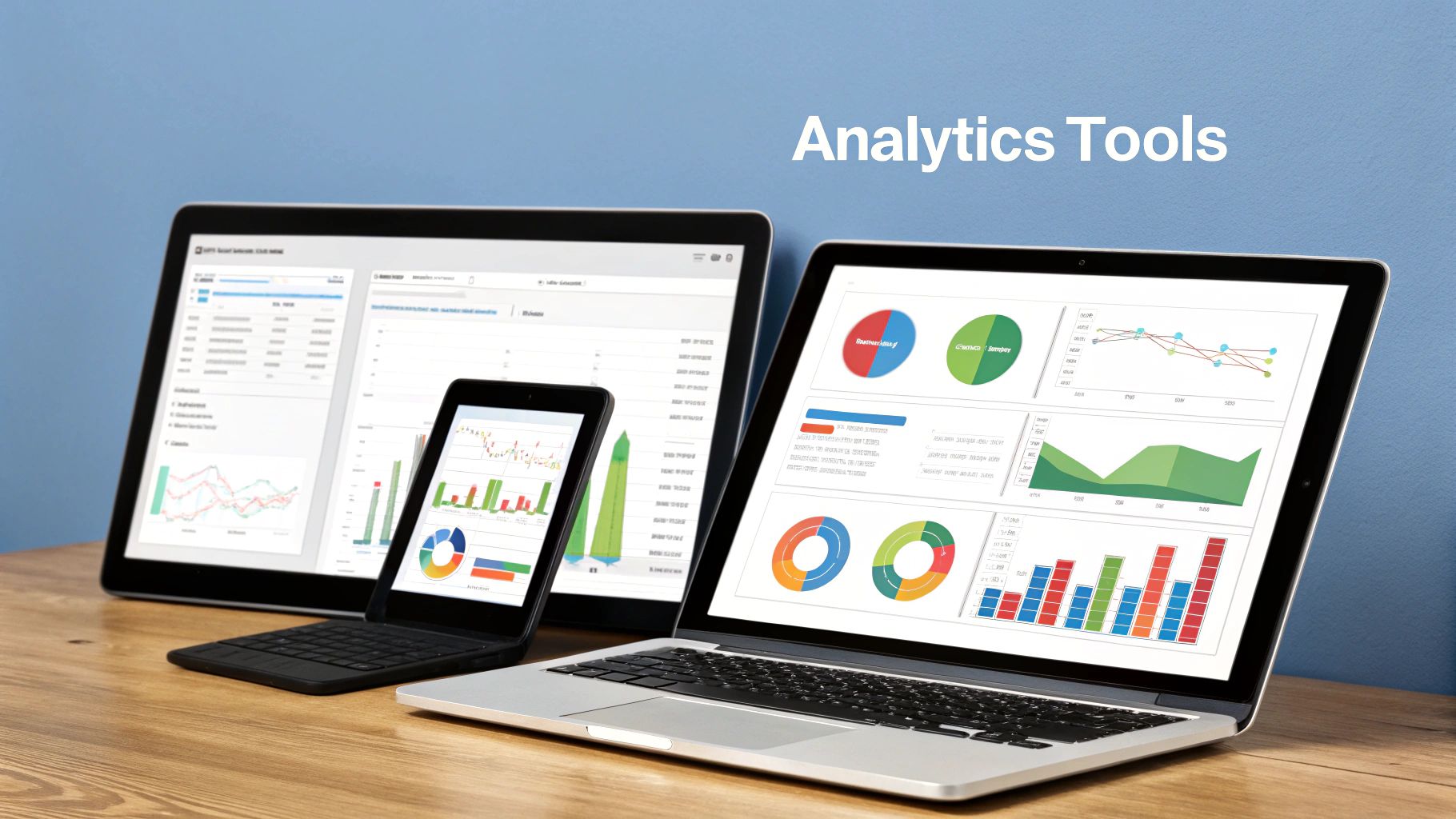Understanding The Foundation of Content Performance Analysis

Content performance analysis is more than simply gathering data. It's a strategic discipline that can significantly contribute to business growth. It's about understanding your audience and what resonates with them. Then, you can use this knowledge to refine your content strategy for better results. This means looking beyond superficial metrics and focusing on the measurements that have a direct impact on your bottom line.
Defining Content Performance Analysis
Effective content performance analysis begins with a clear understanding of the key metrics involved. A great starting point is this helpful article about content performance metrics. Content performance analysis is all about evaluating how effectively your content achieves its intended goals. These goals can range from building brand awareness to generating leads and ultimately driving sales.
This evaluation requires a comprehensive approach. You need to consider a variety of factors, such as audience engagement, reach, and conversion rates. For example, a blog post designed to generate leads might be considered successful if it leads to a substantial number of email sign-ups.
The Importance of a Strategic Approach
Effective marketers don't treat performance analysis as a quarterly report. Instead, they view it as a continuous conversation with their audience. This ongoing analysis allows for constant improvement and adaptation to evolving audience preferences. It means regularly monitoring key metrics and adjusting your strategy based on the resulting insights.
A strategic approach also requires aligning your content goals with your overall business objectives. This ensures that your content efforts directly contribute to your company's success and overall growth.
Connecting Metrics to Business Objectives
A crucial aspect of content performance analysis involves connecting specific metrics to tangible business outcomes. This means identifying Key Performance Indicators (KPIs) that accurately reflect your progress toward your established goals.
For instance, if your goal is to build brand awareness, you might track metrics like social media shares and website traffic. However, if your primary objective is to boost sales, your focus should shift to metrics like conversion rates and lead generation. This focused approach allows you to accurately measure the effectiveness of your content in achieving specific business objectives.
Avoiding Common Measurement Mistakes
Many businesses fall into the trap of tracking vanity metrics. These are metrics that may look impressive but don’t provide actionable insights. They might include things like page views or follower count, which don't always correlate with actual business success. Focusing on these surface-level metrics can lead to wasted time and resources.
Instead, concentrate on metrics that directly impact your bottom line. This might involve tracking conversions, customer lifetime value, or return on investment (ROI). By prioritizing meaningful metrics, you gain a more accurate understanding of your content’s true impact. This understanding empowers you to make informed decisions that ultimately drive business growth.
Choosing KPIs That Actually Drive Business Results
Focusing on Key Performance Indicators (KPIs) that directly align with your core business objectives is essential for measuring success. Tracking superficial metrics like page views or follower count can be misleading. Prioritizing KPIs ensures your content efforts contribute to tangible outcomes, influencing decisions and driving growth.
Aligning KPIs With Content Types and Business Goals
Analyzing content performance requires identifying the right KPIs based on the content type and distribution platform. Different content types demand different KPIs. For example, website content like blog posts and landing pages might prioritize metrics like bounce rate and conversion rates.
Social media content, distributed across platforms like Facebook, YouTube, and Instagram, might focus on engagement rates and reach. Content performance measurement is key to understanding the digital landscape.
Email campaigns often prioritize open rates and click-through rates. Understanding these nuances helps tailor your measurement strategy for actionable insights. How to master SEO performance metrics offers a deeper dive into website-specific KPIs.
To illustrate the various KPIs for different content types, consider the following table:
KPI Selection Guide by Content Type A comprehensive comparison of essential KPIs for different content types and their corresponding platforms
| Content Type | Primary KPIs | Secondary KPIs | Platform Tools |
|---|---|---|---|
| Website Content (Blog Posts, Landing Pages) | Bounce Rate, Conversion Rate, Time on Page | Page Views, Session Duration, Exit Rate | Google Analytics, That's Rank |
| Social Media Content (Facebook, Instagram, YouTube) | Engagement Rate (Likes, Comments, Shares), Reach, Impressions | Follower Growth, Video Views, Click-Through Rate | Platform Native Analytics |
| Email Campaigns | Open Rate, Click-Through Rate, Conversion Rate | Unsubscribe Rate, Bounce Rate, Spam Complaints | Email Marketing Platforms (e.g., Mailchimp) |
This table summarizes some of the key metrics used for each content type and suggests common platform tools for tracking them. Choosing the appropriate KPIs is crucial for accurately measuring content performance and making informed decisions.
The Power of Trends and Data Visualization
Analyzing trends in your KPIs over time provides valuable insights. Instead of focusing on isolated data points, look for patterns and understand what factors contribute to changes. For instance, a sudden increase in website traffic could be due to a successful social media campaign or a viral piece of content. Tracking these trends helps refine your strategy, build on strengths, and address weaknesses.

This infographic emphasizes the importance of a continuous loop: define KPIs, track metrics, and review results to refine your strategy. This ensures your content measurement stays aligned with evolving business goals, crucial for sustainable content performance improvements.
Automating Reporting While Retaining the Human Element
Automation tools can streamline reporting. Platforms like That's Rank offer automated alerts, customizable data exports, and detailed historical analytics. This frees up time for strategic analysis and decision-making. However, remember that automation should support, not replace, human analysis. Interpreting insights from automated reports within the right context remains essential.
Building Benchmarks for Continuous Improvement
Creating benchmarks helps measure progress and drive continuous improvement. Compare your current performance against past performance, industry averages, or competitor performance. Realistic benchmarks create a framework for evaluating success and identifying improvement areas. Regularly revisiting and adjusting these benchmarks keeps your content strategy aligned with market trends and evolving business goals. This constant adaptation is crucial for staying competitive and achieving long-term success. Prioritizing these strategic considerations ensures your content analysis translates into tangible business results.
Essential Tools and Platforms for Meaningful Content Analysis

Choosing the right content analysis tools can be a daunting task. This section explores several effective platforms, ranging from free services like Google Analytics to comprehensive enterprise-level suites. This guide will help you select the best tools for your specific needs and budget.
Google Analytics: The Foundation of Content Performance Analysis
Google Analytics is a robust free tool providing extensive data on website traffic and user behavior. It often serves as the foundation of content analysis, offering essential metrics such as page views, bounce rate, and session duration. Understanding these metrics is key to seeing how users interact with your content.
Google Analytics also allows for custom reporting and audience segmentation. This enables a more focused analysis, making it a valuable resource for businesses of all sizes. A small business might find the basic features sufficient, while a larger company could leverage its more advanced capabilities.
Platform-Native Analytics: Leveraging Built-in Insights
Many platforms, like social media networks (e.g., Facebook, Instagram) and email marketing services, offer built-in analytics dashboards. These native tools offer valuable platform-specific data. For example, Facebook Insights provides data on post reach, engagement, and audience demographics.
Email marketing platforms offer similar benefits, tracking important metrics like open rates, click-through rates, and conversions. Using these platform-native tools is essential for understanding your content's performance within each ecosystem.
Third-Party SEO Tools: Deeper Dives and Competitive Intelligence
Third-party SEO tools offer in-depth analysis of content performance. Tools like Semrush and Ahrefs offer competitive analysis, keyword research, and backlink tracking. These features provide crucial information about your search result rankings, competitor keywords, and backlink quality.
Optimizing your content for search engines requires understanding these factors. For further reading on SEO tools, check out this article: How to master SEO with these recommended tools. This knowledge empowers you to make data-driven decisions for your content strategy.
Building Your Analytics Stack: Combining Tools for a Complete Picture
Using a combination of tools offers a more complete view of your content performance. Integrating Google Analytics with platform-native analytics and third-party SEO tools creates a powerful analytics stack. This integrated approach provides a deeper understanding of how your content performs across different channels.
However, it's important to be selective with your data. Focus on the metrics most relevant to your business objectives and use the tools that deliver the most actionable insights. This strategic approach prevents data overload and maximizes the value of your analytics.
Automated Reporting and Data Visualization: Streamlining Your Workflow
Many analytics platforms offer automated reporting, saving you time and effort by delivering regular performance updates. Data visualization tools within these platforms transform raw data into easy-to-understand charts and graphs. This visual representation makes it easier to identify trends, patterns, and areas for improvement.
By streamlining your workflow with automated reports and data visualization, you can focus on strategic analysis and optimization rather than manual data processing. This allows you to allocate more time to refining your content strategy based on clear, visually presented data.
Advanced Techniques That Separate the Pros From Amateurs
Moving beyond basic metrics like page views and bounce rate is crucial for a comprehensive understanding of content performance. It means delving into more sophisticated measurement approaches that uncover deeper insights into your content's true impact. This section explores these advanced techniques, equipping you with the tools to analyze your content like a seasoned professional.
Hyper-Personalization and Attention Metrics: The Future of Content Analysis
The future of content performance analysis hinges on advanced techniques like hyper-personalization and attention metrics. Hyper-personalization uses machine learning and data analytics to tailor content to individual user profiles. This level of customization can significantly impact engagement.
In fact, studies show hyper-personalized content can boost engagement rates by up to 202%, fundamentally changing how users interact with brands. This signifies a shift towards truly understanding individual user behavior and preferences. Learn more about content marketing effectiveness.
Attention metrics move beyond simple engagement metrics like clicks and likes. They aim to measure how long users actually focus on your content and which elements capture their attention most effectively. This granular analysis allows for precise optimization of content design and delivery, leading to more effective communication and an improved user experience.
Heatmaps, Session Recordings, and Interactive Content Analytics
Understanding user behavior on a granular level requires specialized tools. Heatmaps visually represent where users click, scroll, and hover on your web pages. This helps identify areas of interest and potential usability issues. For insights on various tools that can assist in content analysis, consider exploring resources on: AI Productivity Tools.
Session recordings allow you to replay individual user sessions, offering a deeper understanding of their navigation paths and interactions. These tools provide a qualitative perspective that complements quantitative data from traditional analytics platforms.
Furthermore, interactive content analytics track user engagement with elements like quizzes, polls, and calculators. This data reveals valuable insights into user preferences and knowledge gaps, informing future content strategy decisions. By understanding which interactive elements resonate most with your audience, you can tailor your content to better meet their needs and interests.
Translating Advanced Techniques Into Business Outcomes
Investing in these advanced techniques is not just about collecting more data; it's about making data-driven decisions that impact your bottom line. These techniques translate into measurable business outcomes in several ways.
For example, hyper-personalized content can lead to increased conversions and customer lifetime value. Improved user experience, driven by insights from heatmaps and session recordings, can reduce bounce rates and improve site navigation.
Moreover, data from interactive content analytics can inform product development and marketing campaigns. By leveraging these insights, businesses can create more effective content that resonates with their target audience, ultimately leading to increased engagement, conversions, and revenue growth. These techniques are crucial for success in today’s competitive marketing environment.
Connecting Content Metrics to Real Business Value and ROI

Analyzing content performance is crucial for any successful content strategy. However, the true power lies in connecting these metrics to demonstrable business value and ROI. This means shifting focus from superficial metrics to those directly impacting your financial objectives. This approach allows you to showcase the effectiveness of your content efforts to stakeholders and justify future investments.
From Engagement to Revenue: Understanding the Connection
Many marketers monitor engagement metrics such as website traffic and social media shares. While these metrics offer valuable insights into audience interest, they don't provide a complete picture of content performance. The critical next step is understanding how engagement translates into revenue. For example, driving increased website traffic through a blog post can generate more leads with effective calls-to-action and lead capture forms.
Content performance analysis should extend beyond simply measuring engagement. It's essential to also track conversions, customer acquisition costs, and the lifetime value of customers acquired through your content. This comprehensive approach offers a more accurate understanding of your content’s true business impact. Current data underscores the importance of measuring content's business impact: 53% of marketers prioritize tracking engagement, while 14% identify content marketing as their primary ROI driver. For a deeper dive into these statistics, see how to content performance statistics 2025.
Attribution Modeling and the Customer Journey
Understanding the complete customer journey influenced by your content requires a strategic approach. Attribution modeling helps pinpoint which touchpoints, including your content, contributed to a conversion. This can involve a single-touch attribution model, crediting the last interaction before conversion, or a multi-touch model, distributing credit across multiple interactions.
Consider a customer who discovers your brand through a blog post, then interacts with a social media advertisement, and finally converts after clicking on an email campaign. Understanding the influence of each touchpoint allows you to optimize your content strategy and allocate resources effectively, maximizing content contribution throughout the sales funnel. For a more detailed understanding of calculating ROI, explore this article on How to Calculate SEO ROI.
Measuring Direct and Indirect ROI
Calculating content ROI can be intricate, encompassing both direct and indirect returns. Direct ROI, focusing on revenue directly generated by specific content, is relatively straightforward to measure. This could include e-commerce sales from a product blog post or leads generated through gated content.
Indirect ROI, encompassing factors like brand awareness, thought leadership, and customer loyalty, is more challenging to quantify. While not immediately translating into revenue, these elements contribute significantly to long-term brand growth and customer relationships. A comprehensive ROI calculation should consider both direct and indirect contributions to accurately assess your content's overall value.
To illustrate the ROI of different content formats, let's examine the following table:
Content Format ROI Performance Analysis: Comparative data showing ROI performance across different content formats and marketing channels.
| Content Format | Average ROI | Engagement Rate | Conversion Impact |
|---|---|---|---|
| Blog Posts | 15% | 5% | Medium |
| Case Studies | 25% | 7% | High |
| Video Content | 20% | 10% | High |
| Social Media Posts | 10% | 8% | Low |
| Email Newsletters | 30% | 3% | Medium |
This table highlights the varying ROI performance across different content formats. Email newsletters, for example, demonstrate the highest average ROI, while video content exhibits the highest engagement rate. Understanding these nuances can help inform content strategy decisions.
Presenting Data to Stakeholders: Securing Buy-In
Effectively communicating content performance analysis to stakeholders is essential for securing continued support. Utilize clear visualizations and avoid technical jargon, focusing on how content directly contributes to business objectives and ROI. This could involve presenting data on lead generation, customer acquisition costs, or revenue attributed to content marketing efforts.
By presenting a compelling narrative supported by data, you can gain buy-in from executives and secure the necessary budget to maintain and expand successful content strategies. This translates to ongoing resources and support for your content initiatives.
Turning Data Into Strategic Content Improvements
Analyzing content performance goes beyond simply collecting data. It's about turning those insights into actionable strategies for improvement. This means connecting raw numbers to strategic decisions that boost your content’s impact and achieve your business goals. This section will guide you through proven methods for interpreting performance data and making strategic content improvements that deliver measurable results.
A/B Testing: Optimizing Content Elements for Maximum Impact
A/B testing is a valuable technique for optimizing individual content elements. It involves creating two versions of a piece of content with one variation, such as a different headline, image, or call to action. By comparing the performance of both versions, you can determine which resonates better with your audience.
For example, you could A/B test two different headlines for a blog post to see which generates more clicks. Alternatively, test two different calls to action to see which leads to more conversions. A/B testing provides concrete data to guide your optimization efforts and maximize content effectiveness.
Data-Driven Content Strategy: Informing Key Decisions
Successful marketers leverage performance data to inform broader content strategy decisions. This includes using data to choose topics, select appropriate content formats, and determine the most effective distribution channels.
Analyzing search data can reveal trending topics relevant to your audience. Engagement data from social media can indicate which content formats perform best. Conversion data can highlight which distribution channels are most effective for driving leads or sales. These insights provide a solid foundation for creating a data-driven content strategy.
Continuous Improvement: Systematically Enhancing Content Performance
Content optimization is an ongoing process, not a one-time event. Establishing a framework for continuous improvement is crucial for systematically enhancing content performance over time. This involves regularly analyzing data, identifying patterns, troubleshooting underperforming content, and scaling successful strategies.
For example, if you see a consistent drop in engagement for a specific content type, investigate the potential causes. This might involve analyzing user feedback, reviewing competitor strategies, or reevaluating your target audience. By identifying the root cause, you can implement targeted solutions.
Identifying Patterns and Troubleshooting Underperforming Content
Analyzing data can reveal valuable patterns. You might find that certain types of content perform better on specific days of the week or times of the day. This information can then be used to inform your content scheduling strategy.
Data analysis can also help identify underperforming content and uncover the underlying reasons. This might involve analyzing metrics like bounce rate, time on page, or conversion rate. By understanding why content isn't performing well, you can make informed adjustments to improve its effectiveness.
Scaling Successful Strategies Across Your Content Portfolio
After identifying successful content strategies through data analysis, it’s important to scale those strategies across your entire content portfolio. This involves replicating the elements that contributed to the success of your best-performing content. This could include using similar headlines, formats, or calls to action.
However, it’s also important to stay flexible and adapt strategies based on ongoing performance data. This might involve A/B testing different variations or adjusting your approach based on audience feedback. By continuously refining your content strategy based on data, you can maximize the impact of your content efforts.
That's Rank offers a comprehensive suite of tools to analyze content performance, track keyword rankings, and monitor competitor performance. From identifying trending topics to optimizing individual elements, That's Rank empowers you to make data-driven decisions that improve your content’s impact and achieve your business objectives. Start optimizing your content strategy today with That's Rank.